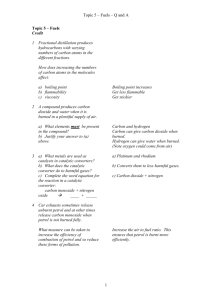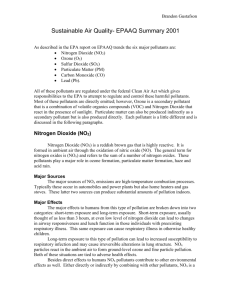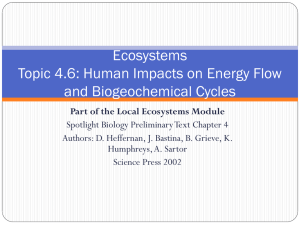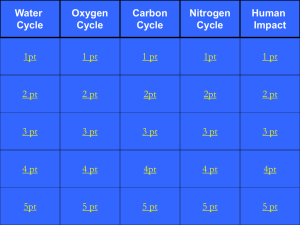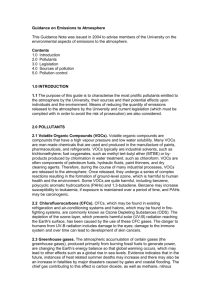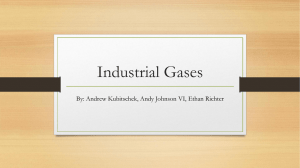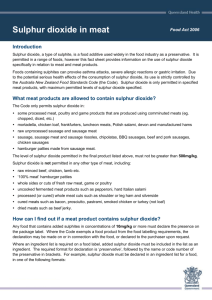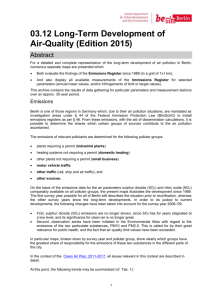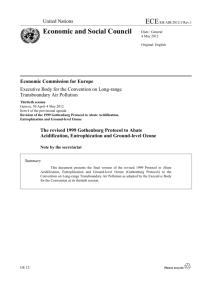Sources of Ppollution And Health Effects
advertisement
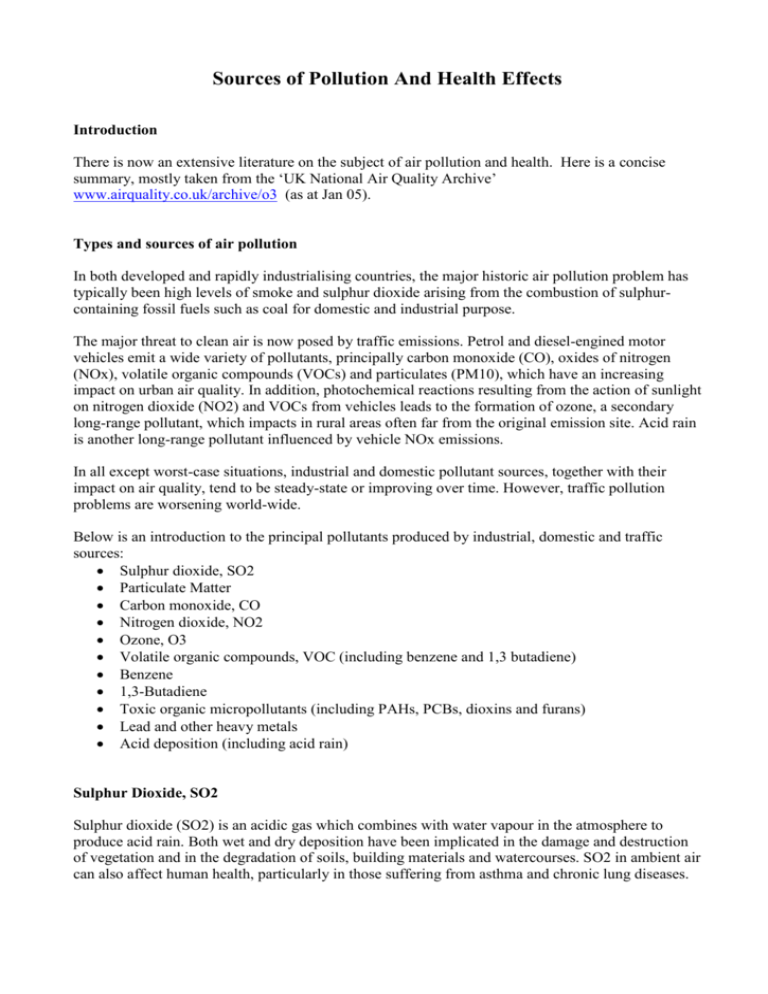
Sources of Pollution And Health Effects Introduction There is now an extensive literature on the subject of air pollution and health. Here is a concise summary, mostly taken from the ‘UK National Air Quality Archive’ www.airquality.co.uk/archive/o3 (as at Jan 05). Types and sources of air pollution In both developed and rapidly industrialising countries, the major historic air pollution problem has typically been high levels of smoke and sulphur dioxide arising from the combustion of sulphurcontaining fossil fuels such as coal for domestic and industrial purpose. The major threat to clean air is now posed by traffic emissions. Petrol and diesel-engined motor vehicles emit a wide variety of pollutants, principally carbon monoxide (CO), oxides of nitrogen (NOx), volatile organic compounds (VOCs) and particulates (PM10), which have an increasing impact on urban air quality. In addition, photochemical reactions resulting from the action of sunlight on nitrogen dioxide (NO2) and VOCs from vehicles leads to the formation of ozone, a secondary long-range pollutant, which impacts in rural areas often far from the original emission site. Acid rain is another long-range pollutant influenced by vehicle NOx emissions. In all except worst-case situations, industrial and domestic pollutant sources, together with their impact on air quality, tend to be steady-state or improving over time. However, traffic pollution problems are worsening world-wide. Below is an introduction to the principal pollutants produced by industrial, domestic and traffic sources: Sulphur dioxide, SO2 Particulate Matter Carbon monoxide, CO Nitrogen dioxide, NO2 Ozone, O3 Volatile organic compounds, VOC (including benzene and 1,3 butadiene) Benzene 1,3-Butadiene Toxic organic micropollutants (including PAHs, PCBs, dioxins and furans) Lead and other heavy metals Acid deposition (including acid rain) Sulphur Dioxide, SO2 Sulphur dioxide (SO2) is an acidic gas which combines with water vapour in the atmosphere to produce acid rain. Both wet and dry deposition have been implicated in the damage and destruction of vegetation and in the degradation of soils, building materials and watercourses. SO2 in ambient air can also affect human health, particularly in those suffering from asthma and chronic lung diseases. The principal source of this gas is power stations burning fossil fuels which contain sulphur. Major SO2 problems now only tend to occur in cities in which coal is still widely used for domestic heating, in industry and in power stations. As many power stations are now located away from urban areas, SO2 emissions may affect air quality in both rural and urban areas. The last 40 years have seen a decline in coal burning (domestic, industrial and in power generation) As a result, ambient concentrations of this pollutant in the UK have decreased steadily over this period. Both the Air Quality Strategy and the EU 1st Daughter Directive (1999/30/EEC) contain limit values for ambient concentrations of sulphur dioxide. Even moderate concentrations may result in a fall in lung function in asthmatics. Tightness in the chest and coughing occur at high levels, and lung function of asthmatics may be impaired to the extent that medical help is required. Sulphur dioxide pollution is considered more harmful when particulate and other pollution concentrations are high. Particulates, PM10 Airborne particulate matter varies widely in its physical and chemical composition, source and particle size. PM10 particles (the fraction of particulates in air of very small size (<10 µm)) are of major current concern, as they are small enough to penetrate deep into the lungs and so potentially pose significant health risks. Larger particles meanwhile, are not readily inhaled, and are removed relatively efficiently from the air by sedimentation. The principal source of airborne PM10 matter in European cities is road traffic emissions, particularly from diesel vehicles. Fine particles can be carried deep into the lungs where they can cause inflammation and a worsening of the condition of people with heart and lung diseases. In addition, they may carry surface-absorbed carcinogenic compounds into the lungs. Although PM10s are the fraction that is normally measured and the one for which standards are normally set, there is increasing evidence that the particles at the smaller end of size range are the more dangerous. It is now widely considered that PM2.5 (particulates smaller than 2.5 microns) should be measured as well as PM10 and that standards for PM2.5 should be set. Carbon Monoxide, CO Carbon monoxide (CO) is a toxic gas which is emitted into the atmosphere as a result of combustion processes, and is also formed by the oxidation of hydrocarbons and other organic compounds. In European urban areas, CO is produced almost entirely (90%) from road traffic emissions. It survives in the atmosphere for a period of approximately one month but is eventually oxidised to carbon dioxide (CO2). This gas prevents the normal transport of oxygen by the blood. This can lead to a significant reduction in the supply of oxygen to the heart, particularly in people suffering from heart disease. Nitrogen Dioxide NO2 Nitrogen oxides are formed during high temperature combustion processes from the oxidation of nitrogen in the air or fuel. The principal source of nitrogen oxides - nitric oxide (NO) and nitrogen dioxide (NO2), collectively known as NOx - is road traffic, which is responsible for approximately half the emissions in Europe. NO and NO2 concentrations are therefore greatest in urban areas where traffic is heaviest. Other important sources are power stations, heating plants and industrial processes. Nitrogen dioxide can irritate the lungs and lower resistance to respiratory infections such as influenza. Continued or frequent exposure to concentrations that are typically much higher than those normally found in the ambient air may cause increased incidence of acute respiratory illness in children. Ozone, O3 Ground-level ozone (O3), unlike other pollutants mentioned , is not emitted directly into the atmosphere, but is a secondary pollutant produced by reaction between nitrogen dioxide (NO2), hydrocarbons and sunlight. Ozone levels are not as high in urban areas (where high levels of NO are emitted from vehicles) as in rural areas. Sunlight provides the energy to initiate ozone formation; consequently, high levels of ozone are generally observed during hot, still sunny, summertime weather. Ozone irritates the airways of the lungs, increasing the symptoms of those suffering from asthma and lung diseases. Volatile Organic Compounds (VOCs) Volatile organic compounds (VOCs) are released in vehicle exhaust gases either as unburned fuels or as combustion products, and are also emitted by the evaporation of solvents and motor fuels. Benzene is a VOC which is a minor constituent of petrol. The main sources of benzene in the atmosphere in Europe are the distribution and combustion of petrol. Of these, combustion by petrol vehicles is the single biggest source (70% of total emissions). 1,3-butadiene, like benzene, is a VOC emitted into the atmosphere principally from fuel combustion of petrol and diesel vehicles. 1,3-butadiene is also an important chemical in certain industrial processes, particularly the manufacture of synthetic rubber. Possible chronic health effects include cancer, central nervous system disorders, liver and kidney damage, reproductive disorders, and birth defects Toxic Organic Micropollutants TOMPs (Toxic Organic Micropollutants) are produced by the incomplete combustion of fuels. They comprise a complex range of chemicals some of which, although they are emitted in very small quantities, are highly toxic or carcinogenic. Compounds in this category include: PAHs (PolyAromatic Hydrocarbons) PCBs (PolyChlorinated Biphenyls) Dioxins Furans TOMPS can causing a wide range of effects, from cancer to reduced immunity to nervous system disorders and interfere with child development. There is no "threshold" dose - the tiniest amount can cause damage. Lead and other heavy Metals Particulate lead in air results from activities such as fossil fuel combustion (including vehicles), metal processing industries and waste incineration. Its single largest industrial use world-wide is in the manufacture of batteries. As tetraethyl lead, it has been used for many years as an additive in petrol; most airborne emissions of lead in Europe therefore originate from petrol-engined motor vehicles. With the increasing use of unleaded petrol, however, emissions and concentrations in air have declined steadily in recent years. Even small amounts of lead can be harmful, especially to infants and young children. In addition, lead taken in by the mother can interfere with the health of the unborn child. Exposure has also been linked to impaired mental function, visual-motor performance and neurological damage in children, and memory and attention span. Acid Deposition When power stations, factories, houses and cars emit pollution into the air, it contains chemicals known as sulphur dioxide and nitrogen oxides. These chemicals may either fall directly back to the Earth due to gravity, or they may mix with water (moisture) in the air to form acids. Once acids have formed, they can be transported long distaiuk87nces by the wind before being deposited in rain, snow or hail. This is what we commonly call acid rain. Acid rain can have harmful impacts on the environment. It affects freshwater lakes and the wildlife that depend upon them. It also affects trees by harming leaves and soil, and it damages buildings made of limestone and marble.
